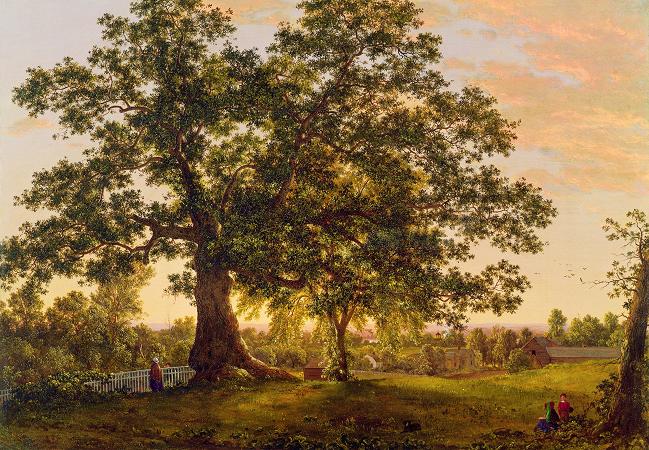Oak Tree. An oak is a hardwood tree or shrub in the genus Quercus of the beech family. They have spirally arranged leaves, often with lobed edges, and a nut called an acorn, borne within a cup. The genus is widely distributed in the Northern Hemisphere; it includes some 500 species, both deciduous and evergreen. Fossil oaks date back to the Middle Eocene. Molecular phylogeny shows that the genus is divided into Old World and New World clades, but many oak species hybridise freely, making the genus's history difficult to resolve. Ecologically, oaks are keystone species in habitats from Mediterranean semi-desert to subtropical rainforest. They live in association with many kinds of fungi including truffles. Oaks support more than 950 species of caterpillar, many kinds of gall wasp which form distinctive galls, roundish woody lumps such as the oak apple, and a large number of pests and diseases. Oak leaves and acorns contain enough tannin to be toxic to cattle, but pigs are able to digest them safely. Oak timber is strong and hard, and has found many uses in construction and furniture-making. The bark was traditionally used for tanning leather. Wine barrels are made of oak; these are used for aging alcoholic beverages such as sherry and whisky, giving them a range of flavours, colours, and aromas. The spongy bark of the cork oak is used to make traditional wine bottle corks. Almost a third of oak species are threatened with extinction due to climate change, invasive pests, and habitat loss. In culture, the oak tree is a symbol of strength and serves as the national tree of many countries. In Indo-European and related religions, the oak is associated with thunder gods. Individual oak trees of cultural significance include the Royal Oak in Britain, the Charter Oak in the United States, and the Guernica Oak in the Basque Country. Oaks are hardwood trees, deciduous or evergreen, with spirally arranged leaves, often with lobate margins; some have serrated leaves or entire leaves with smooth margins. Many deciduous species are marcescent, not dropping dead leaves until spring. In spring, a single oak tree produces both staminate flowers in the form of catkins, and small pistillate flowers, meaning that the trees are monoecious. The fruit is a nut called an acorn, borne in a cup-like structure known as a cupule; each acorn usually contains one seed and takes 6-18 months to mature, depending on the species. The acorns and leaves contain tannic acid, which helps to guard against fungi and insects. There are some 500 extant species of oaks. Trees in the genus are often large and slow-growing; Q. alba can reach an age of 600 years, a diameter of 13 feet and a height of 145 feet. The Granit oak in Bulgaria, a Q. robur specimen, has an estimated age of 1637 years, making it the oldest oak in Europe. The Wi'aaSal tree, a live oak in the reservation of the Pechanga Band of Indians, California, is at least 1000 years old, and might be as much as 2000 years old, which would make it the oldest oak in the US. Among the smallest oaks is Q. acuta, the Japanese evergreen oak. It forms a bush or small tree to a height of some 30 feet. Global distribution of Quercus. The New and Old World parts are mostly separate clades. Red: North American. Pink: Central American. Yellow: European. Green: West/Central Asian. Turquoise: Southeast Asian. Blue: East Asian. See Phylogeny chapter/tree for sections. The genus Quercus is native to the Northern Hemisphere and includes deciduous and evergreen species extending from cool temperate to tropical latitudes in the Americas, Asia, Europe, and North Africa. North America has the largest number of oak species, with approximately 160 species in Mexico, of which 109 are endemic, and about 90 in the United States. The second greatest area of oak diversity is China, with approximately 100 species. In the Americas, Quercus is widespread from Vancouver and Nova Scotia in the south of Canada, south to Mexico and across the whole of the eastern United States. It is present in a small area of the west of Cuba; in Mesoamerica it occurs mainly above 1000 metres. The genus crossed the isthmus of Panama when the northern and southern continents came together and is present as one species, Q. humboldtii, above 1000 metres in Colombia.
more...














